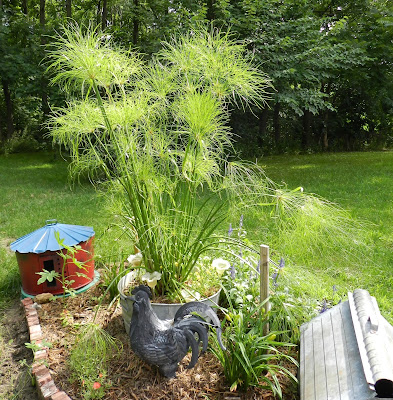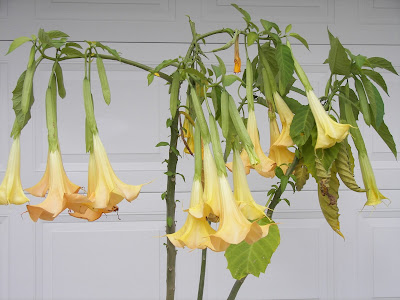I have a small (ish) patch of asparagus "Purple Passion". It gives me enough to eat each week from early spring into fall if I keep it picked.Today I made Asparagus-Custard Pie and it was a resounding success.
I learned how to prep asparagus from a Jacques Pepin lesson. When I pick my asparagus, I only take it down to where it crisply pops off, then rinse, shake and peel the stems with a vegetable peeler. For this recipe, I chopped the stems in 1/4 inch pieces and left the top flowers.
Asparagus-Custard Pie
Line a 9-inch single round cake pan in pie dough. It can be homemade or pre-made refrigerated type. Smooth the sides and crimp the edge. Set in the refrigerator.
4 Eggs - hand whisk lightly
1/3 C Sugar
1/2 tsp Salt
1 T Mrs. Dash Seasoning
1 C Milk - scalded
1 C Light cream - scalded
1/2 C Asparagus - prepared as above
1 T Butter
Fry asparagus in butter until tender but not soft or brown. Mix all seasonings into the eggs.
Whisking continually, slowly add scaled milk/cream into the eggs (you don't want to cook the eggs.)
Spread asparagus evenly on the pie shell. Gently pour egg mixture over. Bake in preheated 400 degree oven until a knife inserted 1-inch from edge of pie comes out clean (it was 25 minutes in my oven.) TIP: Baking too long makes a watery custard. The center will look soft but it will set as the custard cools.
Cool on rack for 30 minutes. TIP: May be served at room temperature or cold from the refrigerator. If refrigerated, don't cover. Should be served the same day.
NOTE: This is not a quiche. It has the same consistency of traditional custard - smooth and silky.
This recipe was based on the Country-Kitchen Custard Pie recipe from the Farm Journal Complete Pie Book and modified for my recipe. Published in 1965, this book is a treasure of wonderful tried and true pie recipes from women who made them every week for their family dinners and dessert for guests. A farm woman worth her salt always had the Farm Journal magazines and recipe books for a reason.
To digress: My mother made pie from scratch every week; enough to have pie every meal of every day - including breakfast. Most were fruit pies for every day. Company pies were chocolate, lemon, banana, coconut, butterscotch (all with meringue) and custard. My Grandma Shenk also made an amazing beef mincemeat. Let's just say pie is in my DNA.
Back to keeping asparagus picked: It will quickly go to seed which will often give you more plants. Keeping it picked keeps it within boundaries and keeps it sending up new shoots. If it all goes to seed, the plant thinks its yearly cycle is done and will often stop sending up new shoots. Eventually, in the fall, I let it go to seed to insure I have new plants next year.
Asparagus gone to seed
TIP: Don't have time to cook fresh-picked asparagus immediately? Add 1/2-inch of water to a glass and put the fresh asparagus in it and then in the refrigerator. It will keep another few days. If vase is not refrigerated, it will continue to mature and will eventually start setting seeds which takes the freshness away.
TIP: If you don't own a very sharp vegetable peeler, get one today! Yes, right now! Caveat: after you finished reading this. Quality vegetable peelers are not expensive and can be found in most big box stores, kitchen/cook speciality stores or on line. Throw away that old dull one - yes, do it now! My current one is an easy to hold, turquoise Kitchen Aid version. The blades produce a serrated cut.
To peel asparagus: Hold the asparagus by the flower end. Run the vegetable peeler down the stem to the cut edge. Turn the stem to get all sides. Simple and easy IF you have a sharp peeler. By peeling the stems, even the more large or tougher stems may be used without worrying if they are too chewy - a lot less waste.
Final TIP of the article: Scalding milk. Don't skip this step. I use a small but deep non-stick heavy saucepan. After adding milk & cream, set on the smallest burner/lowest flame and turn down to slowly bring to a moment where steam is heavily coming up but it doesn't boil or form a skin. If it comes to a full boil or burns, you will need to start over so best to keep a watch on this while you're prepping other things.
There are many many asparagus recipes to help you keep harvesting and eating it every week during the summer. The many choices keep it from being boring.
And YES, it does make your pee smell funky: "The main culprit is aspargusic acid, which is found exclusively in asparagus. When asparagus is digested, asparagusic acid gets broken down into sulfur containing byproducts. Sulfur, in general, is not very pleasant to smell, notes Dr. Bobart of the Cleveland Clinic. When you pee, the sulfur byproducts evaporate almost immediately, causing you to smell that unpleasant scent".
The benefits of asparagus are pretty darn outstanding:
Just one-half a cup (90 grams) of cooked asparagus contains:
- Calories: 20
- Protein: 2.2 grams
- Fat: 0.2 grams
- Fiber: 1.8 grams
- Vitamin C: 12% of the RDI
- Vitamin A: 18% of the RDI
- Vitamin K: 57% of the RDI
- Folate: 34% of the RDI
- Potassium: 6% of the RDI
- Phosphorous: 5% of the RDI
- Vitamin E: 7% of the RDI





















